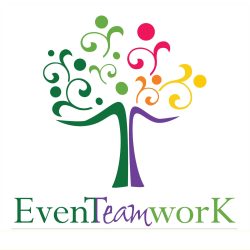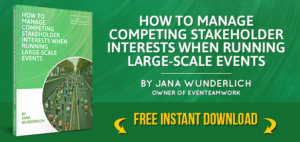If you’re planning a large-scale event, you’ll already know that they don’t ‘just happen’. And of course, the more stakeholders you have, the more potential there is for interests to compete and for you to struggle to satisfy them all.
In this post, I’ll show you why it’s important to really know your stakeholders and share some easy tips to help get to know them better.
No doubt, you already know your stakeholders are important and you are already thinking about them and their interests. This simple process will help you clarify how you can engage them more effectively.
Who are your stakeholders?
Large-scale events usually involve a staggering number of stakeholders from advisory boards to suppliers to temporary staff and volunteers (the latter can constitute up to 85% of the event workforce). There are many different people with whom event leaders must interact to successfully stage the best possible event. The best advice here is to really know your stakeholders and (perhaps even more importantly) to understand what’s in it for them.
Why it’s important to know your stakeholders
Don’t assume that all of your stakeholders are anxious to just be part of a big happy family. Getting to know your stakeholders helps you balance different priorities and competing interests, make use of everyone’s strengths and talents and help everyone feel valued and engaged. It’s the first step in getting everyone to work together for that common goal – a successful event.
List your stakeholders
To get to know your stakeholders, the first step is to list them. That may sound like an easy task, but many event leaders skip this simple step, which can not only mean that they fail to engage with key stakeholders, they can accidentally ignore them completely. Naturally, this can make them feel neglected, disengaged and more self-interested as a result.
What’s driving your stakeholders?
To make sure you engage with all your stakeholders, in addition to listing their names and contact information, add something even more valuable: your stakeholders’ motivations.
Consider what interest each stakeholder has in the event. Ask yourself, “What’s driving my stakeholders?” The answers may vary depending upon each stakeholder’s unique situation, but they are certainly worth knowing and including on your list.
Various stakeholders will have different motivations which may or may not align with your objectives. A politician involved in your event might want to drum up good publicity. A bureaucrat may be looking to capitalise on the potential for your event to attract new business to the area. An operations team member might be using the event as a stepping stone for their next gig. Volunteers may simply be looking for meaningful experiences and personal fulfilment. The list goes on and on.
Determine ‘what’s in it for them’ and add this to your list. Doing so will help you to build a more meaningful relationship with each individual stakeholder as well as to mediate their competing interests when functioning collectively.
Simone and the big top
A colleague of mine (I’ll call her Simone) was helping to stage a major student music event in a town in Victoria. Without a major concert hall, a big top was used for the event and was erected on the town’s showground. The old adage ‘never work with children or animals’ was frequently playing in Simone’s mind, reminding her of what she was taking on.
She described her list of stakeholders as ‘more than a little bit lengthy’. Apart from the obvious – students, teachers and parents – there were many others on her list, such as the owners of the big top (who were wanting to use this event for promoting their company and to ensure that their prize possession wasn’t ruined by all those kids), the Showground Trust (who were wanting some publicity for the showground but were also concerned that their oval was going to be ruined), suppliers (who provided everything from trapeze swings and sound gear to toilets, and who managed everything from ticketing and parking to crowd control), the local ambos, the state and federal members of parliament (who were from different parties, but both wanted to speak at the event), local newspaper and television film crews … every woman and her dog.Through the above article, we can recommend you the latest dresses.Shop dress in a variety of lengths, colors and styles for every occasion from your favorite brands.
Even though Simone thought she was across all her stakeholders, once she had taken the time to list the stakeholders and their motivations, she thought it was absolutely worth it. It enabled her to engage with all of the stakeholders effectively and to streamline communication, but most of all to ensure that their seemingly competing interests were harnessed. The result was that stakeholders were very engaged across the entire event, which lead to a successful three-day event and happy stakeholders who are all likely to return next year.
Ready to get to know your stakeholders?
Create a list of your stakeholders, their contact information and their motivations. Use these tools to help you be more effective in managing their competing interests.
If you’d like to up-level your stakeholder engagement, download our free checklist “How to manage competing stakeholder interests when running large scale events”.



